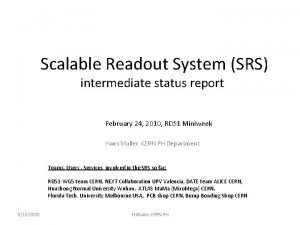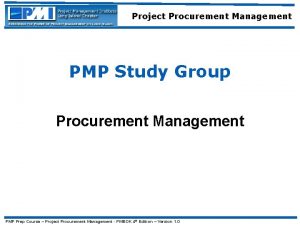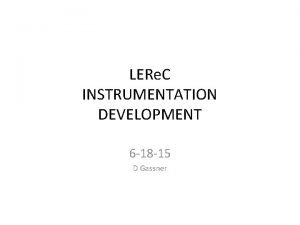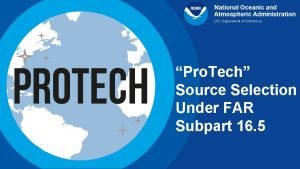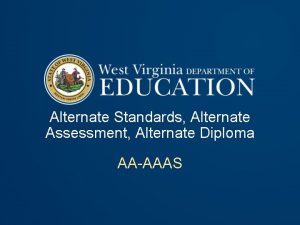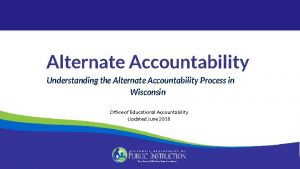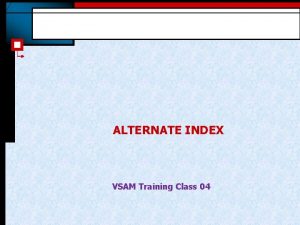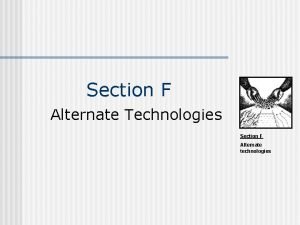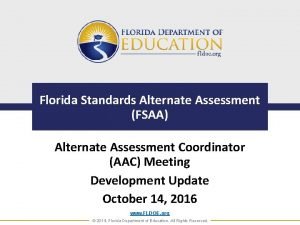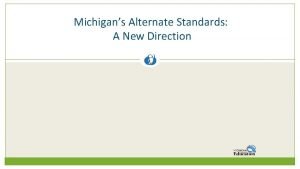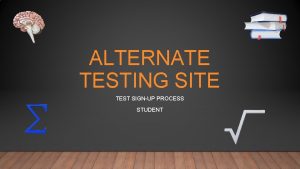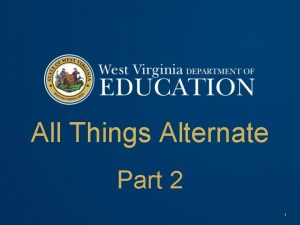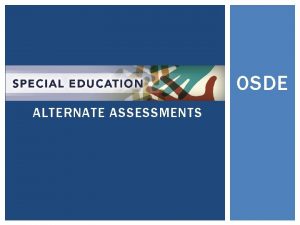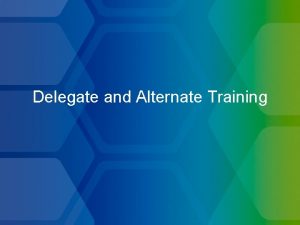Alternate Source Selection Approaches For Competitive Procurements 25




















- Slides: 20

Alternate Source Selection Approaches For Competitive Procurements <$25 M 1

Agenda • • • Welcome Safety message Ground Rules History of Midrange Definitions Processes Pricing Proposal Instructions and Evaluation Questions and Answers 2

Safety and Administrative Restrooms can be found in the hallway outside this room as well as upstairs. Vending machines are here on the first floor by the back entrance. Fire exits are out the front entrance and side exit doors. In the event of a fire, you must move at least 75 feet away from the building. 3

Ground Rules • Questions will be addressed at the end of the presentation. Any question unable to be answered at this time will be answered at a later date. • The slides being presented today will be placed on the NASA Procurement website for your use. • This discussion is generic and not for any particular procurement. Questions on specific procurements must be submitted to the CO pursuant to designated procedures. 4

History • 1993 – NASA Established a “Midrange” Test Program. • 1997 – Test Portion Expired, All special Midrange procedures had now been incorporated into FAR Parts 12, 14, 15. • 2004 –NASA issued guidance on the use of alternative source selection approaches and rating methods currently available within the flexibilities of the FAR for negotiated acquisitions less than $50 M. 5

History • 2005 – JSC Mid. Range Replacement Team was chartered to assist in implementing the guidance for the Alternate Source Selection Process. • 2006 – JSC Mid. Range Replacement Redesign Team was chartered to further define and provide more guidance in its use and implementation. 6

Definitions • “Best value” as defined in FAR 2. 101: – The expected outcome of an acquisition that in the Governments estimation provides the greatest overall benefit in response to the requirement • “Trade-off” is defined in FAR 15. 101 -1 as: – It is in the best interest of the Government to consider award to: 1) other than the highest technically ranked offeror 2) other than the lowest priced offeror. 7

Source Selection Processes • Methods of Source Selection >$25 M, traditionally uses SEB process • Trade off between all non-cost related factors and cost/price • Uses Mission Suitability >$100 K to <$25 M, JSC plans to use Alternate Source Selection process • Streamlines process • Uses Best value 8

Alternate Source Selection Processes Negotiated Acquisitions >$100 K and <$25 M Use the Source Selection approach that will result in selection of the Offeror providing the best value to the Government based on the requirements of the contract and the contract type. 1) Lowest Priced Technically Acceptable 2) Lowest Priced Technically Acceptable with Past Performance 3) Use of Trade-Off Analysis 9

Alternate Source Selection Processes 1) Lowest Priced Technically Acceptable – Similar to sealed bid approach – Clarifications can be requested from any or all Offerors prior to source selection to ensure offerors understand the requirements and to determine acceptability. – Trade-offs are not permitted. – No additional credit is given for exceeding acceptability. – Past performance is not evaluated. ALTHOUGH NOT TYPICALLY USED AT JSC, THIS METHOD CAN BE USED WHEN REQUIREMENTS ARE WELL DEFINED AND TECHNICAL AND PERFORMANCE RISKS ARE MINIMAL 10

Alternate Source Selection Processes 2) Lowest Priced Technically Acceptable with Past Performance considered – – – Same as the “Lowest Priced Technically Acceptable” except that Offerors’ past performance is also a discriminator. Clarifications can be held with any or all offerors prior to source selection to ensure offerors understand the requirements and to determine acceptability. Past Performance is evaluated for acceptability USED WHEN REQUIREMENTS ARE WELL DEFINED AND TECHNICAL AND PERFORMANCE RISKS ARE MINIMAL. HAVING AN ACCEPTABLE PERFORMANCE RECORD IS SUFFICIENT. 11

Alternate Source Selection Processes 3) Use of trade-off analysis – Uses a combination of technical acceptability and trade-off of Qualitative value characteristics (VC). – The baseline (minimum requirements) are defined in the solicitation (e. g. Spec/SOW, safety & health, & quality) – Qualitative value characteristics (VC) beyond the baseline will serve as the discriminators among offers. – Trade-off Analysis allows award to other than the lowest priced Offeror or other than the highest technically ranked Offeror. USED WHEN PERFORMANCE UNDER QUALITATIVE VALUE CHARACTERISTICS ARE IMPORTANT ENOUGH TO DO A TRADE-OFF ANALYSIS MORE THAN LIKELY, WILL BE THE MOST TYPICAL BEST VALUE ANALYSIS USED AT JSC. 12

Section L – Instructions for Trade -Off Proposals • Section L addresses what items are considered Baseline and which are Qualitative Value Characteristics with instructions on how to propose. – Technical Acceptability • Baseline Requirements – Scope of Work, Task Order, Etc. – Others such as Safety and Health Requirements Plan, Small Business Subcontracting Plan, Phase-In Plan, Quality Plan etc. – Past performance – Cost/Pricing – Qualitative Value Characteristics are: • Any items that may be considered as value added to the contract 13

Quality Assurance Requirements • Quality Assurance Requirements are Dependent on the Specific Procurement – Quality Requirements Specified in SOW and Data Requirement Descriptions (DRD) – Typical Flight Related Requirements • Quality Assurance Plan • Process and Product Specifications • Capabilities to Comply Verified – Data from Past Customers – Data from Government Agencies – Physical Site Visit – Other Procurements e. g. Admin Services, Facilities, Non-Flight, hazardous operations, etc. • May have varying degrees of quality requirements – Information provided will be verified 14

Pricing Information Requirements • Ensure the cost is fair and reasonable • Proposal must be suitable for evaluation – This means the proposal should provide the following: • Accounting for all resources necessary to complete requirements of the contract • Traceability to the technical/management proposals • Explanation of pricing and estimating techniques explained • Disclosure of basis of all projections, rates, ratios – to facilitate the Government’s understanding and validation • A narrative that explains all subjective elements of cost projections • Submission of all required cost and compensation RFP templates 15

Pricing Information Requirements • Concurrent cost proposal to DCAA (if applicable) • RFP may provide standard labor categories (SLC) – Facilitates the Government’s evaluation of labor and groups a broad range of categories into a manageable number of classifications – Offerors may include additional/different categories, but they must map to the SLCs provided • RFP may provide an Independent Government Estimate (IGE) – IGE is the Government’s estimate of the magnitude of the work by labor resources/skill mix – Each offeror’s should develop their own estimate that supports their unique proposed management and technical approach 16

Section M – Evaluation Factors for Trade-Off Proposals Section M addresses how the Government will evaluate the Baseline and Qualitative Value Characteristics proposed. Typical Section M Evaluation Factors include: • Technical Acceptability: (e. g. Spec/SOW, safety & health, & quality) – Meets or Does Not Meet Requirements • Past Performance – Rated Excellent, Very Good, Fair or Poor • A neutral rating will be given to offerors with no past performance • Cost/Pricing – Perform cost realism analysis (if the competition does not establish price reasonableness) and a price analysis • Qualitative Value Characteristics (VC) – These areas will be rated as “significant value-added, minimal value-added or no value-added” 17

Observations from a Customer’s Perspective • Propose to the RFP – Don’t let incumbency, being on site, or rumors drive your proposal • Read carefully the RFP and respond to the RFP rather than what you think the Government might want • Pay attention to Sections L and M – Tell you what the Government expects in your proposal and how the Government will evaluate your proposal • For the Value Characteristics (VC) – If you want credit for an item as a VC, be sure to address it as a VC rather than just mention it in other parts of the proposal • For Pricing and Cost proposal – Follow the templates • Let you know what the Government expects in the cost data • Facilitate consistent evaluation • Deviations to the Independent Government Estimate or Standard Labor Categories – First make sure the RFP permits you to make deviations – If it does, be sure to provide the rationale for those changes (i. e. the benefit to the Government from those changes) 18

Observations from a Customer’s Perspective • Take advantage of opportunities to ask questions (for example, 1 -on-1 sessions, website, and email forums) – Procurement teams will tell you if they can’t answer the question • If you don’t ask, you have already assumed it can’t be answered • Conduct a final spell check, grammar check, and format check before you submit your proposal – Proposal materials make your first impression to the Government – make it your best • Assess your firm's capability in light of all the RFP requirements – Proposal preparation is time-consuming and consumes resources – Carefully determine whether or not you are capable of fully meeting the Government’ s requirements before you take on the expense of a proposal • Continue to monitor the procurement websites for opportunities – Propose on those for which you truly feel you are qualified • The more valid proposals the Government receives, the better value the Government receives 19

Questions • Questions? ? ? • Comments or suggestions may be submitted electronically to Carol Devany at carol. devany-1@nasa. gov 20
 Procurements
Procurements Project procurement management definition
Project procurement management definition Procurements
Procurements Which market is the least competitive
Which market is the least competitive Therapeutic index
Therapeutic index Market commonality and resource similarity examples
Market commonality and resource similarity examples Natural selection vs artificial selection
Natural selection vs artificial selection Balancing selection vs stabilizing selection
Balancing selection vs stabilizing selection Artificial selection vs natural selection
Artificial selection vs natural selection Two way selection and multiway selection in c
Two way selection and multiway selection in c Two way selection and multiway selection
Two way selection and multiway selection Artificial selection vs natural selection
Artificial selection vs natural selection Disruptivr selection
Disruptivr selection Mass selection and pure line selection
Mass selection and pure line selection K selected
K selected What is exponential growth in ecology
What is exponential growth in ecology Natural selection vs artificial selection
Natural selection vs artificial selection Contractor past performance examples
Contractor past performance examples Source selection advisory council
Source selection advisory council Verifikationsplan
Verifikationsplan Karttecken ruin
Karttecken ruin
